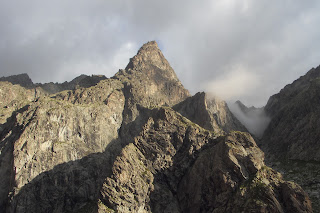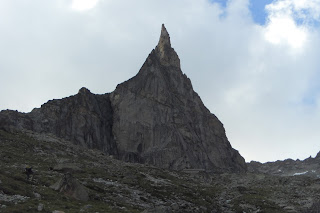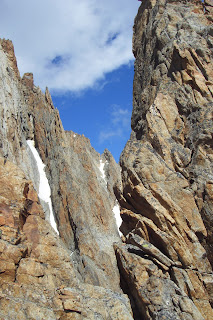Finally, we
did it!!! After driving a lot of kilometres first to Val di Mello, then to the
Ecrins, back home to Holland and then again to the Bergell we managed it to
climb one of the big north faces in the Alpes.
I spent two
days at home when the weather forecast suddenly changed and predicted a good
weather window for at least three days. I drove back to Basel, picked up Bernd
and again we went to the beautiful Bergell in the very south east of Switzerland.
The Badile
is a 3307m peak, which is well-known for
its granite quality and is famous for it’s routes. The north ridge is first
climbed in 1923 and is accessible to climbers who easily climb long routes (up
to 25 pitches and a difficulty level of 5a max). Back in 2008 I climbed that
route together with Peter. Another
well-known route is the long route in the north east face climbed in 1937 by
the alpine legend Ricardo Cassin. He opened the route in three days (free and
artificial climbing), on the last day they were caught in terrible weather which
caused the death of two climbing mates! The Cassin-route on Badile is one of
the most famous north faces in the Alpes together with the Eiger, Matterhorn,
Grand Jorasses, Les Droites and Les Drus. Nowadays the route is climbed in one
day and usually It takes 6-10 hours for the climb itself, another hour to the
top of the Badile and three hours down to the Italian side.
At arrival
on the Sasc Fura hut we got the information that maybe there is still ice and
water in the north east face especially in the exit chimneys. Bad news if you
have to climb 20 pitches up to 6a+ in a route from where it’s difficult to
retreat. But our motivation was still high and we thought to give it a try and
decide at the start of the route.
The next
morning we started at 4.30h, the face looked quite dry and we were at the base
of the route at 7.00h (one abseil to get to ledge, making the traverse under
the serac and climbing up to the start). There were already 2 parties climbing
and another 2 parties starting. Unfortunately the latter ones were very slow so
we actually had to wait a lot which made it a very long but exciting climbing
day. On the other hand the weather forecast predicted no thunder storms and
skies looked really good during the whole climb.
Badile at approach, from the highest point the north ridge comes down towards the observer, the NE-face is to the left (of course)
let's do it!
walking down to work...
the lower part of the face in the first sunlight - terrific!
Bernd
started the first pitch. I had to lead the first difficult pitch, it’s a 6a and
I was a bit nervous, because there are 4-5 difficult pitches in the route, not
bolted and we had quite heavy backpacks (mountain boots, crampons, water,
blizzard pack,…). So I thought, if I climb this pitch solidly I will have a
good day on the mountain, otherwise I
thought it might get a tough one. But the 6a was good to protect with friends,
there were a lot of (old) pitons and I didn’t found it too hard. So I was
really happy after that pitch.
We
continued climbing and the 6th pitch I was leading again. The pitch
makes a traverse to the left, goes up, and turns around a corner to the right.
The traverse to the left is easy but because it’s alpine, I’m used to place a
lot of protection in case of rock fall or whatever can happen to you in this
environment. I started to climb up and suddenly the huge block where I hung on
started sliding. I fell for about 2 meters and then the last clipped piton hold
the fall! After a short assessment I continued the climbing with a painful
right hip, a sore ankle and some scratches on the elbow and hands – I was the
lucky guy that day!!!
the upper part of the face
The
climbing continued on slabs, diedres up to the middle of the wall where you
have to make a traverse under a small snow field to the start of the upper
part, which is the most difficult part of the whole route – 4 pitches starting
with a 6a+, 5c+, 6a, 5c and after that another
7 pitches to the north ridge.
The Spaniards
in front of us chose to avoid the steep crack of the 6a+ and instead they went
up to the right. It took quite long and after 10 minutes or so the lead climber
told the belayer that he would leave his backpack on a piton to continue the
pitch without, because the climbing was too difficult. I thought, ok, let’s go
up the original pitch, it looked really steep but I saw a lot of possibilities
to place protection. It was really sustained climbing and after 25 metres I ran
out of pieces, luckily 2 metres above me I saw two old pitons. I made belay on
the pitons placed the last remaining friend as a third anker – done!!
the crux pitch
nice view: on the right in the foreground Piz Cengalo with the well-known Geiser-Lehman on the north-pillar, the Sciora group in the middle and Piz Bernina with the Bianco ridge in the background
the exit chimneys
We
continued climbing and after another 4 pitches the famous exit chimneys came
into sight. I hoped that they would be dry, the climbing itself should not be
too difficult but if it is wet it can be really hard. At that moment we were on
route for more than 7 hours. The weather was still good and we enjoyed to be on
the mountain. It turned out that the
exit chimneys were wet but climbable, yeah. And again I got a quite difficult
pitch to lead, “just” a 5+ but on the bottom of the V-shaped chimney there was
a lot of water. I had to climb inside to place protection and afterwards climbing
out of the V with either my back on one side and both feet on the other or one
foot on one side and the other on the opposite side – a scarry sensation to
climb like this on the V realizing that the climbing shoes and your hands are
wet. In the older days they called this a III+ section, hahaha. After a nice workout of about 20 minutes I
managed it to get to the belay.

doing the workout in the V-shaped chimney, good exercise :-)
This pitch was the only pitch I climbed without the backpack. In consequence Bernd had to second this pitch and pulling up my backpack as well. He did a great job. After that pitch I got some energy problems maybe as a consequence from my fall earlier that day. Bernd offered me to lead the next pitches (I didn’t say a word but the non-verbal signals I think were obvious). These are the great moments of comradeship in the mountains – taking responsibility for each other without needing a lot of words.
in the exit chimneys
Bernd leading in the chimneys
Bernd led
the next 3 pitches. For me this was enough to recover, get it warm again and at
six o’clock I made the last moves to get out of the cold NE-face into the sun
on the north ridge – GREAT.
the last pitch...
Bernd exiting the NE-face, feel the sun!!
We sorted out our gear and decided to climb on a
running belay technique, which means that we both climb together with about 20
metres rope between us. The lead climber places protection and the secondary
climber cleans up. This is a very efficient way of save and simultaneously
climbing. After another hour we were on top!! We met a few people on our way up
who climbed the north ridge, but they were really tired and decided to stay in
the bivouac hut on the top. For us, this was no option, we wanted to go down and
have a beer on the hut.
feeling like real mountaineers! happy to be out there, thanks Bernd.
We started
the first abseil when suddenly I heard a lot of noise of falling rock and
screaming people on the top. At that moment Bernd already had abseiled down the
first pitch and I stood on the top of the abseil. I never before experienced a
huge rock fall like that one. I saw a huge block coming down from maybe 40
metres above me, I mean huge in sense of huge like my car!!! That block was
slowly tumbling down pulling out a lot of other smaller rocks. I was secured at
the belay and jumped as fast as possible behind a big block. I shouted towards
Bernd that he should move his ass as fast as possible out of the impact zone. A
few seconds later I saw Bernd lying on the ground. He was hit, but responding
to me. It seemed that the Spaniards above us had launched this enourmous
rockfall – they apologized, thanks guys….
I rappelled down to Bernd, he was
conscious but was not able to stand on his feet. He told me that he was hit by
a rock in a size of a football. After a short assessment we decided to wait a
few minutes. I pulled out the ropes and prepared everything to abseil down – if
possible. We had not a lot of options, it already started to get dark and
calling a helicopter would not really be an option. So the best thing would be
to make it down to the hut. I remembered all the abseils from my trip with
Peter 4 years ago. We had a 60 meter rope which would make the abseils very
efficient. After taking some ibuprofen we decided to try to make it down.
Abseil for abseil we did our best to stay calm and indeed I found immediately
all the abseils and the traverses towards the end of the couloir. Bernd did all
the stuff amazingly good. After the last abseil it was dark – good timing. We put
on our head torches and made it down to the hut. We arrived at 23.00h, and the
best thing was: we got some polenta soup and German Wahrsteiner beer, what a
final!! After that we took another beer….
Next
morning it took a while to get up, Bernds hip and stomach were aching and I had
a really sore right hip. But the spirits were high, we climbed the route and
survived a serious rockfall caused by this stupid guys, sorry for these words
but already in the route they were climbing above their limits and then this
shit in our descent.
Anyway, we
walked back to the Sasc Fura hut. A nice hike in a great alpine environment, it
took 6 hours to get to the hut. We had some really good soup and pasta and
after that we walked down for another hour.
Facts: TD+/ED-,
800m, 20 pitches to the north ridge, another 5-6 pitches to the summit, 3 hours
descent to the Gianetti hut. We took a good rack of friends (0,5 – 2), nuts and
10 quickdraws with us. Before starting you should try to get some information
about the serac at the base of the wall (crampons???) and you should think
about the return (rappelling down the north ridge or going down to Italy). From
the Gianetti hut you can walk down in the Val di Mello and rent a taxi to go
back to Switzerland (veryyyyy expensive) or walk back in 6 hours to the Sasc
Fura hut.
And never
forget: Cassin opened this route in 1937!!! Great mountaineer!























































